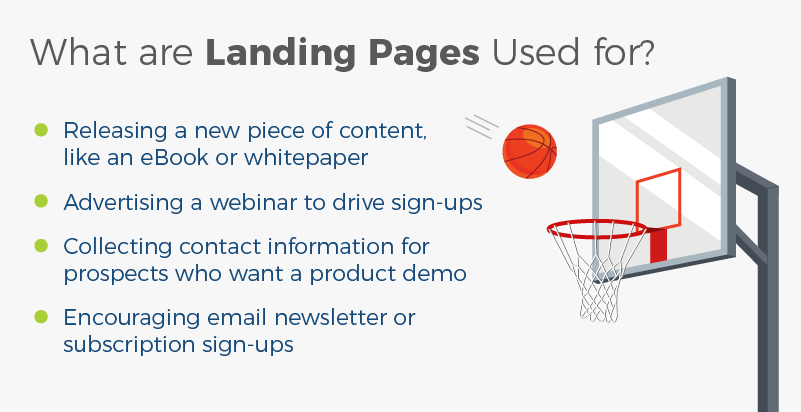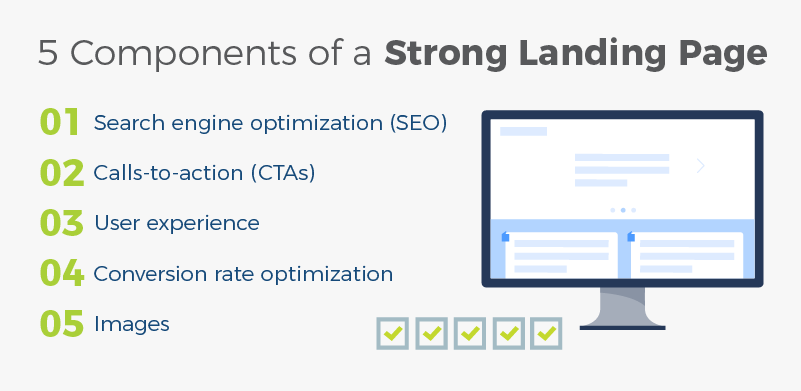Landing Page Best Practices to Attract More Traffic, Convert More Customers
As most in the industry know, the process of improving your marketing metrics is often full of experimentation, testing, and creativity. Although you might be able to pivot and adapt some new strategies, there are certain key elements that help prospects learn more about your company and convince them to become loyal customers.
It’s these strategies that you don’t want to move away from but instead improve. Landing pages fall into this category. By following a few important landing page best practices, you can help ensure that your customers’ first impressions are strong and positive.
If you’re new to the world of website design, you might be asking, “What is a landing page?” Throughout this guide, you’ll discover the true purpose of these elements on your website and what you can do to make them stronger. We’ll also help you gain a foundational understanding of things like landing page SEO so that you can make more informed content decisions.
If you’re ready to put a new spin on your marketing efforts, landing pages could be the gateway to earning more leads each month. And the good news is–you don’t need to be an expert to put these landing page best practices into action! Let’s get started.
What is a Landing Page?
There are plenty of resources available for learning how to build a landing page, but it’s important to develop a foundational understanding of what this page is and does. According to Hubspot, a landing page serves as a page of your website where you can “offer a resource from your business in exchange for a visitor’s contact information.”
Marketers use landing pages when they don’t want to miss a chance to collect contact information from visitors. As a result, you’ll often find that contact forms are one of the primary elements on landing pages.
What are Landing Pages Used for?
The use case list for landing pages is nearly unlimited, but some of the most common g situations include :

Landing pages can be put in place whenever you want to capture information about a visitor or otherwise inspire them to take further action.
5 Components of a Strong Landing Page
Many marketers believe that landing page conversion rates depend on the anatomy of the specific landing page in question. Elements such as the headline, supporting body copy, subheadings, form fields, and other aspects can either convince or discourage a visitor from completing the next steps. If you are clear, concise, and persuasive, website visitors are more likely to follow the instructions on a landing page and engage with the content you’re offering.

A strong landing page is made up of many critical components, each designed to represent your offer and motivate visitors to take action. Below is a sampling of the components you need to implement when designing a custom landing page that converts.
1. Search engine optimization (SEO)
When you want to capitalize on new website traffic, using an SEO landing page can help you meet that goal. To rank high in search engine results, your landing page should offer high-quality content. Although it’s important to perform thorough keyword research to help your landing pages rank, search engines like Google rank pages based on the ability to meet a searcher’s needs. The more helpful and informative your landing page content is, the better your page may perform.
Landing page SEO also encompasses factors like site speed and user experience. Keep the average user in mind, and always incorporate elements that are simple and easy to understand.
2. Calls-to-action (CTAs)
Each landing page that you create should be solely focused on one objective. Sometimes, this is referred to as a conversion goal. Since you can make as many landing pages as you want or need to, each one should be designed for a specific, simplified purpose.
To give your visitor a clear idea of how to leverage the page, always use a well-crafted CTA, or call to action. CTAs can take place in the form of text, or you can implement a button to make the experience more visual.
Landing page best practices include using creativity when it comes to CTAs. Website visitors are so accustomed to phrases like “Click Here” and “Submit Now” that this language may not be enough to inspire action. Instead, try to think outside of the box and use your own unique voice and brand messaging.
3. User Experience
Have you ever clicked on an interesting ad or stumbled upon a new landing page, only to be left completely confused by where to go next? When the design and function of your landing page don’t resonate, users will be quick to abandon whatever it was that inspired them to click in the first place.
When it comes to landing page best practices, user experience includes elements such as:
- Page usability and hierarchy
- Message clarity
- Visual consistency
- Lack of distractions
- Loading time
If your landing page is cluttered, slow, or poorly organized, the end user may have a negative impression and fail to convert. When it comes to leveraging landing page software, always go with options that offer simplicity, strong visual elements, and thoughtful user experience.
4. Conversion Rate Optimization
In most instances, landing pages are designed with customer conversion in mind. Unfortunately, not all landing pages perform at the same rate of success. Conversion rate optimization is the process of taking a closer look at specific elements of your landing pages and improving them.
Improving conversion rate optimization (CRO) on landing pages may involve A/B testing to help you learn more about your customer’s responses and behaviors. Additionally, you may want to take a closer look at your customer value proposition. The CVP answers the question, “Why should I take this particular action?”
When you use a landing page to make the answer to this question very clear, customers are more likely to exchange their contact information for the product, content, or service that you’re promising to deliver.
5. Images
Setting a featured image for your landing page is important when you create landing pages in WordPress and when you share the links on social media platforms. On Facebook, users are 2.3 times more likely to engage with a post that includes a featured image. If you want to drive conversion, you can’t afford to skip this step.
When selecting a featured image, choose a graphic that’s visually appealing and recognizable. Many brands curate an image library in order to have a wide selection of images available that meet brand standards and design.
On your actual landing page, use simple images that don’t distract from the main message. If you’re offering an eBook or other piece of contact, you can use the space to preview the cover page of that deliverable with a mockup.
What Makes a High Converting Landing Page?
Many of the above components play a role in determining whether your specific landing page will convert visitors into prospects or customers. However, there are several other aspects that relate directly to customer conversion. These include:
- Attention-grabbing headlines. Headlines and subheadings are the largest lines of text that your visitors will see when exploring your page. As a result, these headlines should be specific and engaging. If you can drive curiosity or answer an important question, you can clarify what your customer wants and needs to know.
- Persuasive copywriting. With every landing page visit, imagine that your ideal customer is asking, “Why should I care or take action?” Put the skills of your content team to work by producing landing page copy that offers value and inspires action.
- Transparent explanations. Never use landing pages to capture information and then lead customers astray. If you’re advertising a content download, give the visitor a preview of the lessons they’ll learn. If you’re collecting a sign-up for a webinar or event, provide all of the details upfront.
- Options for contact. Chat boxes and other contact options can help legitimize your company or service. Landing pages that include expectations for contact and frequency can also build trust with your incoming leads and prospects.
Top Tools for Building Landing Pages
Whether you use a landing page service or keep this skill in-house, there are many tools you can leverage to improve your website’s landing pages.
By following the landing page best practices outlined in this guide, you’ll be well on your way to acquiring and converting more customers right away. If you’re looking for something more targeted, both free and paid landing page tools can help.
When following landing page practices, some of the most popular options include:
Hubspot:
Hubspot is a super easy landing page builder that also allows you to track conversions and connect your landing page sign-ups to your existing database. From there, it’s easy to automate a nurturing email campaign and track how these new users convert into customers.
Lucky Orange:
Lucky Orange can help you track the user experience on your landing pages. This will give you a better idea of where customers are looking, clicking, and when they leave the page. Use this data to improve your user experience and, therefore, your conversion rate.
Great B2B Landing Page Examples
Most of the time, landing pages are used by B2B companies to convince prospects that a business or service is worth the time and investment. The end goal of B2B landing pages is probably very different from a B2C page since the B2B sales process is often longer and more expensive.
One characteristic of B2B landing pages is that they offer a unique selling point from the start. When selling to other businesses, it’s important to construct messaging around the unique problem that a service can solve. The best B2B landing pages are direct, simple, and free of distractions.
- Slack. Slack is one of the most popular workplace messaging services on the market. It offers advanced integrations, real-time chat features, and enterprise collaboration. Slack’s ‘Get Started’ landing page offers a free trial incentive and a streamlined user experience.
- ActiveCampaign. ActiveCampaign is an email marketing service provider with customizable options. The ‘Request a Demo’ page offers simple form fields, concise explanations of what to expect, and visually appealing branding and design.
- 2checkout. 2checkout is a monetization platform that helps improve global sales experiences. The company’s resource download pages make it easy to obtain useful eBooks, whitepapers, and other downloads. Form fields are simple, and users can see exactly what the download offer includes.
Start Converting Customers Today
Converting customers isn’t a one-size-fits-all strategy. At Striventa, our team of marketing professionals knows how much your company’s unique goals, audience, and values all matter. Our goal is to help you grow your business by utilizing strategies that we know help acquire more customers.
To start developing your own high-performing landing pages today, book your free Exploratory Session. A Striventa team member will be in touch to learn more about your business goals and develop a personalized action plan.

